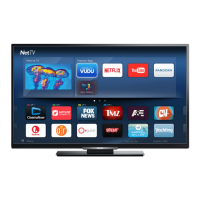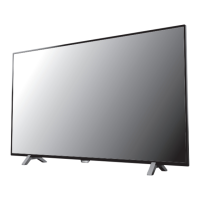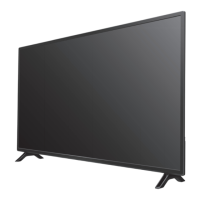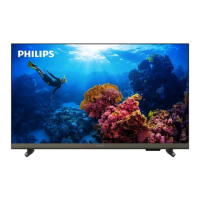Do you have a question about the Philips 43PFL4902 and is the answer not in the manual?
Explains warning symbols and general safety precautions.
Recommendations for safe TV placement and child supervision.
Precautions for safely mounting the TV on walls or ceilings.
Read instructions, heed warnings, avoid water, clean with dry cloth.
Details FCC regulations, modifications, and Canadian notices.
Introduces features like DTV, Autoprogram, Net TV, and Child Lock.
Buttons for menu navigation, source selection, and channel change.
Buttons for media playback, pausing, and accessing streaming services.
Details all input/output ports like HDMI, USB, Ethernet, and audio.
High-quality digital video and audio via HDMI.
Uses EasyLink for TV audio output to audio devices.
Instructions for connecting to the internet via Ethernet cable.
Connects the TV to the internet wirelessly.
Connects and uses USB devices for media playback.
Guides through initial setup steps and menu options.
Configures network and installs channels.
Selects preferred picture and sound modes.
Instructions for turning the TV on/off and adjusting volume.
Controls connected EasyLink devices via TV remote.
Connects USB memory sticks for media playback.
Guides to the best picture and sound settings.
Accesses menus for picture, sound, and usage settings.
Guides through network setup and software updates.
Fine-tuning Backlight, Contrast, Brightness, Color, Tint, Sharpness.
Selecting predefined picture modes for viewing conditions.
Accesses sub-menus for dynamic contrast, color enhancement, etc.
Fine-tuning contrast, color, and black stretch.
Motion enhancement, color balance, and saturation settings.
Selecting sound modes and equalizing volume.
Explains one-touch play, standby, and remote control forwarding.
Guides installing and searching for available TV channels.
Connects the TV to the internet via a wireless LAN.
Connects the TV to the internet via an Ethernet cable.
Guides connecting to a wireless router using Auto or Easy Connect.
Sets IP address, subnet mask, gateway, and DNS.
Tests the TV's connectivity to the home network and internet.
Guides downloading software and updating via USB.
Updates TV software via internet connection.
Steps to wirelessly cast or mirror device screens to the TV.
Solutions for no power, remote issues, and picture quality problems.
Troubleshooting for no sound, distorted audio, and screen size changes.
Explains what the one-year warranty covers and what it excludes.
Explains warning symbols and general safety precautions.
Recommendations for safe TV placement and child supervision.
Precautions for safely mounting the TV on walls or ceilings.
Read instructions, heed warnings, avoid water, clean with dry cloth.
Details FCC regulations, modifications, and Canadian notices.
Introduces features like DTV, Autoprogram, Net TV, and Child Lock.
Buttons for menu navigation, source selection, and channel change.
Buttons for media playback, pausing, and accessing streaming services.
Details all input/output ports like HDMI, USB, Ethernet, and audio.
High-quality digital video and audio via HDMI.
Uses EasyLink for TV audio output to audio devices.
Instructions for connecting to the internet via Ethernet cable.
Connects the TV to the internet wirelessly.
Connects and uses USB devices for media playback.
Guides through initial setup steps and menu options.
Configures network and installs channels.
Selects preferred picture and sound modes.
Instructions for turning the TV on/off and adjusting volume.
Controls connected EasyLink devices via TV remote.
Connects USB memory sticks for media playback.
Guides to the best picture and sound settings.
Accesses menus for picture, sound, and usage settings.
Guides through network setup and software updates.
Fine-tuning Backlight, Contrast, Brightness, Color, Tint, Sharpness.
Selecting predefined picture modes for viewing conditions.
Accesses sub-menus for dynamic contrast, color enhancement, etc.
Fine-tuning contrast, color, and black stretch.
Motion enhancement, color balance, and saturation settings.
Selecting sound modes and equalizing volume.
Explains one-touch play, standby, and remote control forwarding.
Guides installing and searching for available TV channels.
Connects the TV to the internet via a wireless LAN.
Connects the TV to the internet via an Ethernet cable.
Guides connecting to a wireless router using Auto or Easy Connect.
Sets IP address, subnet mask, gateway, and DNS.
Tests the TV's connectivity to the home network and internet.
Guides downloading software and updating via USB.
Updates TV software via internet connection.
Steps to wirelessly cast or mirror device screens to the TV.
Solutions for no power, remote issues, and picture quality problems.
Troubleshooting for no sound, distorted audio, and screen size changes.
Explains what the one-year warranty covers and what it excludes.
| Screen shape | Flat |
|---|---|
| Response time | 8 ms |
| Display diagonal | 43 \ |
| Display brightness | - cd/m² |
| Display technology | LED |
| Native aspect ratio | 16:9 |
| Native refresh rate | 60 Hz |
| Supported video modes | 480i, 480p, 720p, 1080i, 1080p |
| Contrast ratio (typical) | 1200:1 |
| Display diagonal (metric) | 109.2 cm |
| Screen format adjustments | 4:3, 14:9, Zoom |
| Supported graphics resolutions | 640 x 480 (VGA), 720 x 480, 800 x 600 (SVGA), 1024 x 768 (XGA), 1280 x 1024 (SXGA), 1280 x 768 (WXGA), 1360 x 768 (WXGA), 1400 x 1050 (SXGA+), 1440 x 900 (WXGA+), 1680 x 1050 (WSXGA+), 1920 x 1080 (HD 1080) |
| Motion interpolation technology | PMR (Perfect Motion Rate) 120 Hz |
| Equalizer | Yes |
| RMS rated power | 16 W |
| Number of speakers | 2 |
| Equalizer bands quantity | 5 |
| AC input voltage | 120 V |
| Power consumption (standby) | 0.5 W |
| Power consumption (typical) | 55 W |
| On/off switch | - |
| Product color | Black |
| Panel mounting interface | 300 x 200 mm |
| 3D | No |
| Network streaming services supported | Vudu |
| Audio formats supported | AAC, AC3, MP3, WAVE |
| Image formats supported | JPG |
| Video formats supported | AVC, H.264, H.265, HEVC, MPEG1, MPEG2, MPEG4 |
| RF connector type | F |
| RF ports quantity | 1 |
| USB 2.0 ports quantity | USB 2.0 ports have a data transmission speed of 480 Mbps, and are backwards compatible with USB 1.1 ports. You can connect all kinds of peripheral devices to them. |
| S-Video inputs quantity | 0 |
| Consumer Electronics Control (CEC) | EasyLink |
| Tuner type | Analog & digital |
| Supported TV bands | UHF, VHF |
| Analog signal format system | NTSC |
| Digital signal format system | ATSC |
| Wi-Fi standards | 802.11a, Wi-Fi 5 (802.11ac), 802.11b, 802.11g, Wi-Fi 4 (802.11n) |
| Operating temperature (T-T) | 5 - 40 °C |
| Package type | Box |
| Package depth | 162.6 mm |
| Package width | 1059.2 mm |
| Package height | 650.2 mm |
| Package weight | 9979.03 g |
| Music apps | Pandora |
| Video apps | Netflix, YouTube |
| Depth (with stand) | 185.4 mm |
|---|---|
| Height (with stand) | 607.1 mm |
| Weight (with stand) | 7393.6 g |
| Depth (without stand) | 86.4 mm |
| Width (without stand) | 967.74 mm |
| Height (without stand) | 576.6 mm |
| Weight (without stand) | 7302.8 g |












